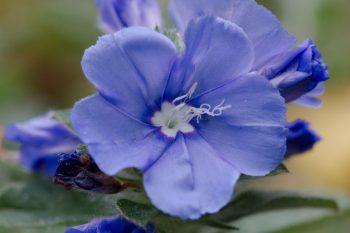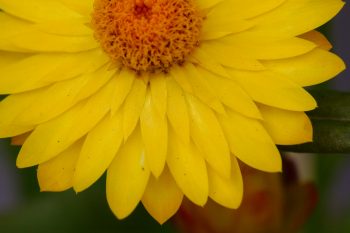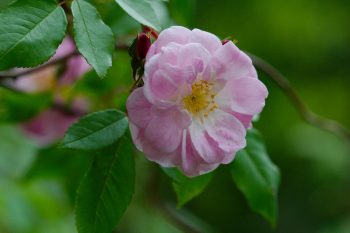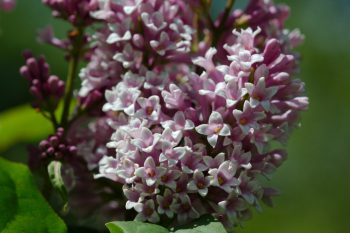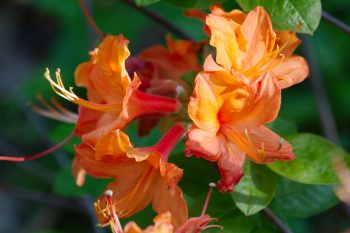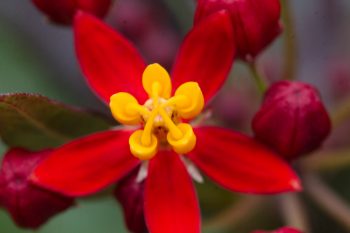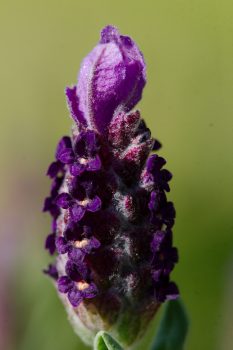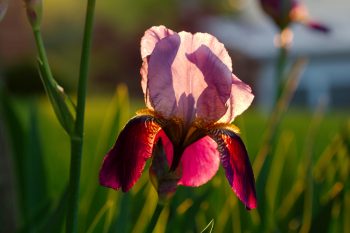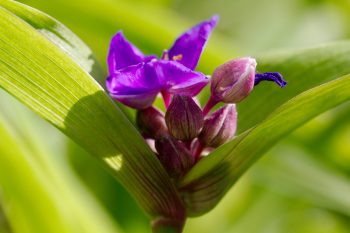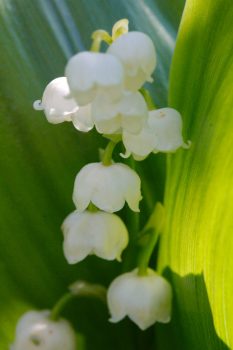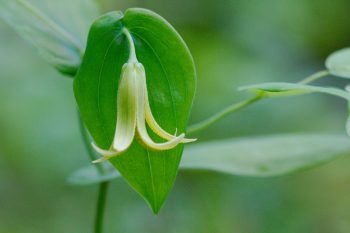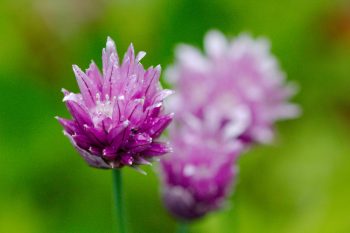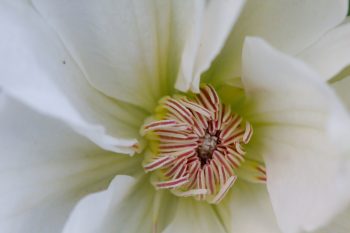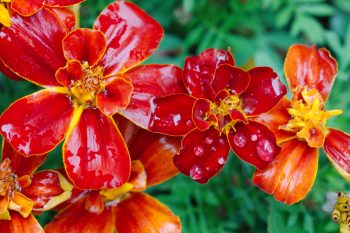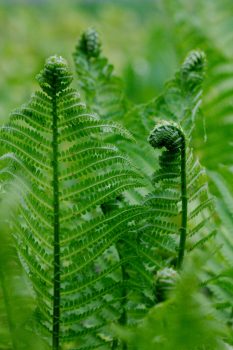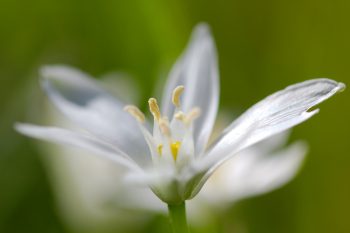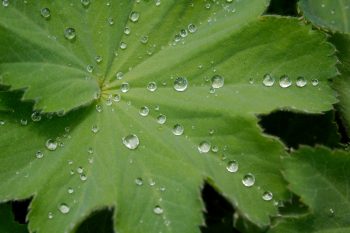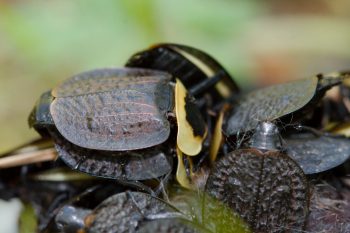This is a European hornet (Vespa crabro). It’s also dead. I found it on the floor of the basement when I stepped on it in my bare feet, which worried me a little. It was mostly dead before I stepped on it and completely dead after that. Since I didn’t get stung, I’m over it. They are predatory on other insects so in general (and outside my basement), I have no problem with them being around. They are similar in size to the eastern cicada killer (Sphecius speciosus) but are quite different in appearance. As large as they are, the European hornet is smaller than the Asian giant hornet (Vespa mandarinia, sometimes referred to as murder hornets), which can be 30% to 50% larger.
Vespa crabro (European Hornet)
Evolvulus ‘Blue My Mind’
This is yet another tender perennial grown here as an annual. It’s a non-vining, morning glory-like plant native to Brazil. It’s a member of the convolvulus family (a.k.a. the bindweed or morning glory family, Convolvulaceae) but it doesn’t twine and the genus, Evolvulus, means to untwist or unravel. This variety, ‘Blue My Mind’, has beautiful, pale, sky-blue flowers about an inch across. This does really well in hanging baskets or other containers and that’s where this is destined to go, but so far it’s among the plants waiting to be potted up.
Strawflower ‘Basket Yellow’
Here’s another of the plants we bought a while back from Fehr’s Nursery. It’s a strawflower called ‘Basket Yellow’. Also known as everlasting flower, the official binomial is Xerochrysum bracteatum although it was formerly included in the genus Helichrysum or Bracteantha. It’s a tender, short-lived perennial native to Australia and treated as an annual here and we have two. This one is pure yellow and the other is red and orange, which is pretty nice. We’ll put them in pots on the back patio and they’ll give us color right through the summer. The flowers, not surprisingly, last a long time. I wonder if that’s where they get their name?
Champneys’ Pink Cluster
This is a difficult rose to photograph well. First, it’s quite tall and most of the blooms are right at the top, about eight feet from the ground. Second, it’s against the south wall of our house, which is brick but not the most attractive background. It was also cloudy today and the rose wasn’t in the bright sun, which would have been nice. But I wanted to be sure to include a photo of this rose, as it’s doing quite well this year. This is one of four roses that survived the great rose dying of last year. It’s by far the tallest of them but the other on the end of the house, which nearly died a few years back, has to potential to be much larger, if it can continue its come back.
Lilacs
Many years ago my dad gave me a subscription to a thing called The Seed Guild. The idea was that this guy had relationships with botanical gardens and arboreta around the world and had worked out an arrangement where he collected seeds from them and distributed them to Seed Guild members. I don’t remember the details but I do know the seeds for this lilac came from there. The catalogs I have (from the late 1990s) list three species, Syringa amurensis, S. josikaea, and S. wolfii, so I assume it’s one of those three. I’m leaning towards the last of them, which may more properly be known now as Syringa villosa subsp. wolfii (C.K.Schneid.). I had it growing in a container for many years and it never got very big. When we moved here in 2006 I planted it in the back garden and now it’s about 8 feet tall and obviously doing well.
Exbury Azalea
After work today I sat out in the yard. It was quite warm and I was enjoying the birds singing in the early evening. There is a family of house wrens (Troglodytes aedon) that have nested in a small, ceramic bird house hanging from our cherry tree and they make themselves known. I got a few photos of the wren but they’re small birds and I wasn’t really that close to it. I also surprised a rabbit (an eastern cottontail, Sylvilagus floridanus), who came around the corner and found himself much closer to me that he would have liked. He froze long enough for me to get a pretty good close up. But I decided to post this photo of the Exbury azalea that’s just finishing up a really nice blooming season.
Asclepias curassavica ‘Silky Red’
One of the plants Cathy bought on our annual Mother’s Day trip to the nursery (a week early this year) was this blood flower, Asclepias curassavica ‘Silky Red’. As you can see, the colors are pretty intense. This species of butterfly weed is native to the Caribbean and Central and South America and is only winter hardy to USDA zones 9 to 11, so we grow it as an annual here but it’s worth it. The butterflies and other insects love it and even without that, it’s just a beautiful flower. If you have a very bright indoor location (or a heated greenhouse!) then you could bring it in for the winter, but we just start new each year.
Lavandula stoechas ‘Anouk Supreme’
Last year, after getting rid of the stump from the Colorado spruce that I cut down, we planted a hawthorn to one side of the bed and Cathy planted some perennials as well. Two of them are a variety of Spanish lavender (Lavandula stoechas) called ‘Anouk Supreme’. They are blooming now and they are quite lovely.
Each individual inflorescence is nice, as you can see here, and overall the entire plant is really nice, with lots of blooms. The individual flowers are a very deep purple and the bracts at the top are only slightly less intense. Both the leaves and the flowers give off that wonderful lavender aroma that we’re all so familiar with.
We haven’t done terribly well with plants like this in the past but I think this is a good location for them. If they do well, I’d be happy to get a couple more. We also have a rosemary that we might put here with them. This species of lavender is native to the Mediterranean countries including France, Spain, Portugal, Italy and Greece.
Backlit Iris
Cathy and I went for a walk in the neighborhood this evening and came across this iris, back lit by the setting sun. It was more purple in real life but I think the photo is pretty nice, anyway. I have a thing for back lighting, particularly of growing things. I love the luminescent quality and amazing colors of leaves and flower petals lit by the sun. I also took photos of our hawthorn, which is in bloom, and the first rose to open on ‘Perle d’Or’ outside our front door. But there will be more chances to photograph those in the days ahead.
Tradescantia virginiana (Spiderwort)
One of our favorite herbaceous perennials is the spiderwort (Tradescantia virginiana). It’s a native and is easily grown in our gardens. In addition to the ‘standard’ versions, we have a few named varieties. This is one of the plain species and it’s lovely, of course. This one is right outside our back door and this is the first bloom of the year. I’ll almost certainly return to it later, when it has more flowers, or will post a photo of one of the other, slightly more exotic varieties. But they really don’t need much improving.
Lily of the Valley (Convallaria majalis)
I know I’ve already had a picture this spring of the lily of the valley (Convallaria majalis) from our garden but it’s blooming so well and so long that I thought I’d share another. We’re also in a little lull where there isn’t a lot new coming out, although it’s still changing. So, here’s another view of the little white bells of the lily of the valley, this time from the back garden, near the fence (not that it makes much difference, of course). Soon the flowers will be gone and even the leaves will fade in the coming heat of summer. We are near the southern limit of where it grows well. If you grow it here, it needs some shade to protect it from the heat of the summer sun but further north it does well in full sun.
We also have a terrific crop of Canadian thistle (Cirsium arvense) coming up among it (and many other places, as well) and it really needs to be dealt with. That’s a really problematical weed, having “a deep and wide-spreading root system with a slender taproot and far-creeping lateral roots.” (Source: Fire Effects Information System, US Forest Service). That same document also says that “new plants can also form from root fragments as short as 0.2 inch (6 mm),” which helps explain why it’s so hard to get rid of.
Uvularia perfoliata (Perfoliate Bellwort)
It was quite cool this morning after a soft freeze over night. There was ice in both bird baths this morning, not just the pedestal meaning it got pretty cold. I had covered my recently planted camellias and we moved some pots into the garage, so everything seems fine. We went for a very nice walk in Rock Creek this afternoon and saw lots of pretty things, including this perfoliate bellwort (Uvularia perfoliata), a pretty little wildflower we don’t see very often. The word ‘perfoliate’ means the base of the leaf surrounds or is pierced by the stem.
Chives
The chives (Allium schoenoprasum) are blooming. These are one of the easiest herbs to grow and we have them both in containers on our back patio and in the ground in our herb garden. We have to keep the oregano from suffocating them, but they have managed to survive so far. They bloom this time every year and I like to pick some of the flowers to sprinkle onto food as a seasoning. They add a subtle oniony flavour without being overpowering. Of course, the tubular chive leaves can be used pretty much any time, but I think the flowers are special, because they add color as well as flavour.
White Flowering Clematis
In the back of our garden, near the fence where there was a huge rose bush, there is a clematis. For years it’s struggled to be seen among the rose, which was often out of control. Well, the rose is gone now, having mysteriously died last year. I’m sad about that, and wish it hadn’t died but at least this beautiful, white clematis is still there and is doing quite well, now that it’s getting the sun it needs and isn’t overshadowed by the huge plant. We will need something for it to clime on but for now, it’s just happy to be blooming in the sun.
Marigold ‘Durango Red’
As mentioned on Sunday, we went to the garden center to buy plants for Cathy to put in containers and into the ground for the summer. These were mostly annuals, although we did buy a few perennials, as well, including a rosemary. This is one of the marigolds that Cathy picked out. It’s called ‘Durango Red’ and it’s a really nice, burnt orange color. It’s especially nice in the rain, which was heavy today. This is out on the driveway right now but it will probably go into the ground before too long. They are a quick and easy way to get a lot of color in your garden.
Frond of Ferns
I’ve used the joke before but it’s true, I’m fond of fern fronds. We have a few different ferns in the yard. There is the northern maidenhair fern (Adiantum pedatum, featured seven times so far, apparently), Japanese painted fern (Athyrium niponicum var. pictum), ostrich fern (Matteuccia struthiopteris), and sensitive fern (Onoclea sensibilis). This is, I believe, a Dryopteris species, but I need to do some work if I’m going to identify it for sure. The genus is generally known as the wood ferns but some species have particular names, like male fern (D. filix-mas, which is what I suspect this is) or buckler fern.
The other species this might be, and perhaps it’s more likely based on size, is the lady fern (Athyrium filix-femina). Both the male fern and lady fern are native and both are nice for a shady garden. I really should figure out which this is because every time I’m asked, I have to qualify my answer. A fern expert could probably look at my photo and tell me right off, but I need to look up the differences and look more carefully. If and when I do that, I’ll update this post.
Ornithogalum umbellatum (Star of Bethlehem)
The Star of Bethlehem (Ornithogalum umbellatum) is a pretty, little, but invasive bulbous plant native to Europe, northern Africa, and the Middle East. It’s coming up in our back yard and we really should do something about it, although it’s hard to want to pull out something as pretty as this. I’m not sure where it came from as we only have it growing in our lawn and not in any of our garden beds. This time of year they just appear in the lawn. Our mower is out of commission until I get a new carburetor so the grass is getting long but once that’s running again, these will be mowed along with the grass.
Alchemilla mollis ‘Auslese’
It’s a week early for Mother’s Day but we’ve been cooped up for too long and we didn’t want to wait until next week. We took our annual trip to Fehr’s Nursery early this afternoon and Cathy bought a load of plants. As usual, I wandered around and took photos of flowers, etc. I got some nice pictures of various hens and chicks (Sempervivum varieties) including some Sempervivum arachnoideum, which have what look like cobwebs on them. I decided to go with this photo, however, of lady’s mantle leaf (Alchemilla mollis ‘Auslese’) with water droplets on it.
Necrophila americana (American Carrion Beetle)
We took a walk near Lake Frank today and had a really nice time. We saw one adult and one juvenile bald eagle next to and on the nest across the lake. It’s too far, really, to get a good picture but I did take a few, anyway, just to record the fact. We happened to come across this pile of American carrion beetles (Necrophila americana), presumably on a piece of carrion. They were definitely there for a reason. It’s fine to get grossed out by them, but then, without them, the rotting meat would stick around a lot longer, so in my book, they’re doing us a service.
Squirrel on a Cow Skull
Cathy and I were out in the back yard and we heard a scratching noise. We’re used to quite a bit of noise from birds and occasional tree frogs, but this was quite different and we didn’t recognize it. We finally noticed this squirrel on the cow skull that’s hanging on our back fence. The squirrel, in typical rodent fashion, was gnawing on the top of the skull. I assume it’s gnawing on the bone to get calcium and other nutrients. Anyway, it’s one of the reasons you only find relatively fresh bones in the wild. They don’t last long unless they get buried (and probably even then).


